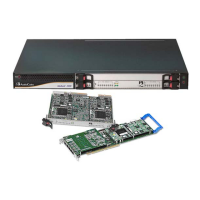Version 5.2 159 September 2007
SIP User's Manual 5. Web-based Management
Table 5-28: Network Settings, Application Settings Parameters
Parameter Description
STUN Settings
Enable STUN
[EnableSTUN]
[0] Disable = STUN protocol is disabled (default).
[1] Enable = STUN protocol is enabled.
When enabled, the gateway functions as a STUN client and
communicates with a STUN server located in the public Internet.
STUN is used to discover whether the gateway is located behind a
NAT and the type of that NAT. In addition, it is used to determine the
IP addresses and port numbers that the NAT assigns to outgoing
signaling messages (using SIP) and media streams (using RTP,
RTCP and T.38). STUN works with many existing NAT types, and
does not require any special behavior from them.
This parameter cannot be changed on-the-fly and requires a gateway
reset.
For detailed information on STUN, refer to 'STUN' on page 367.
Note: For defining the STUN server domain name, use the ini file
parameter STUNServerDomainName (refer to 'Networking
Parameters' on page 273).
STUN Server Primary IP
[STUNServerPrimaryIP]
Defines the IP address of the primary STUN server.
The valid range is the legal IP addresses. The default value is
0.0.0.0.
STUN Server Secondary IP
[STUNServerSecondaryIP]
Defines the IP address of the secondary STUN server.
The valid range is the legal IP addresses. The default value is
0.0.0.0.
NFS Settings
NFS Table For detailed information on configuring the NFS table, refer to
'Configuring the NFS Settings' on page 159.
5.6.3 Configuring the NFS Settings
Network File System (NFS) enables the gateway to access a remote server's shared files
and directories and to handle them as if they're located locally. A file system, the NFS is
independent of machine types, OSs, and network architectures. Up to five different NFS file
systems can be configured.
NFS is utilized by the gateway to load the cmp, ini and configuration files via the Automatic
Update mechanism (refer to 'Automatic Update Mechanism' on page 245).
Note that an NFS file server can share multiple file systems. There must be a separate row
for each remote file system shared by the NFS file server that needs to be accessed by the
gateway.

